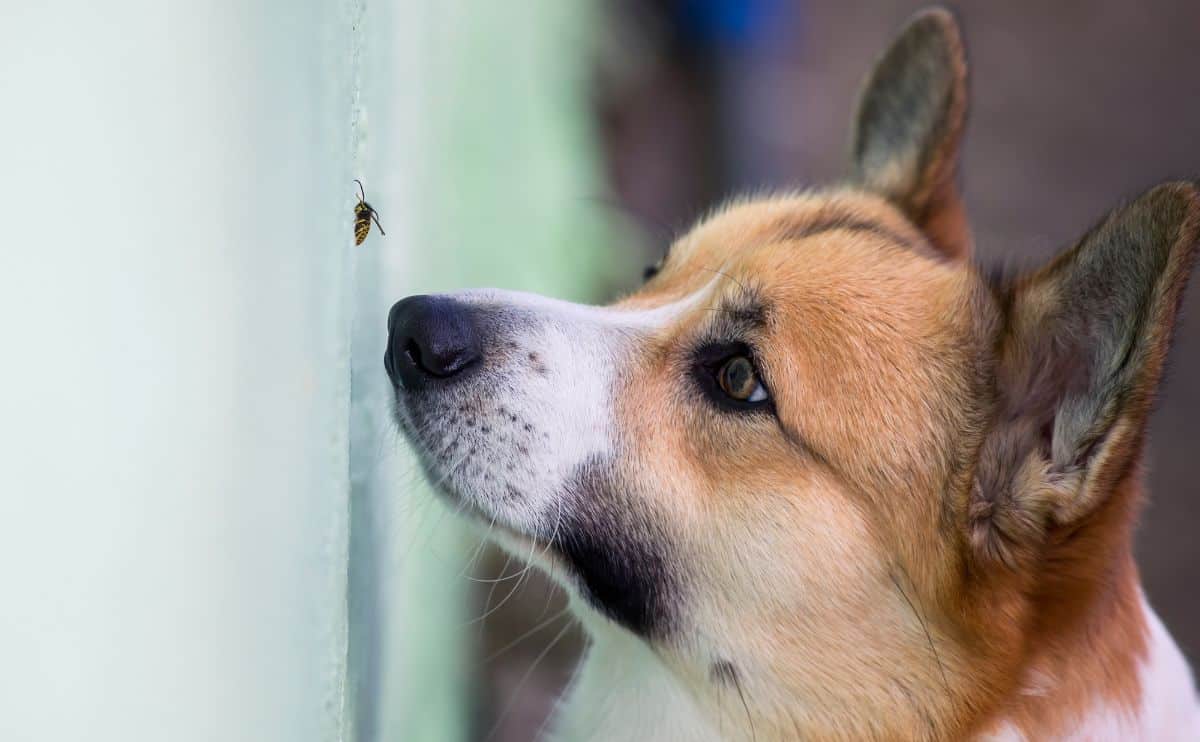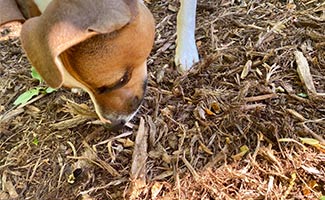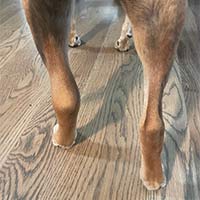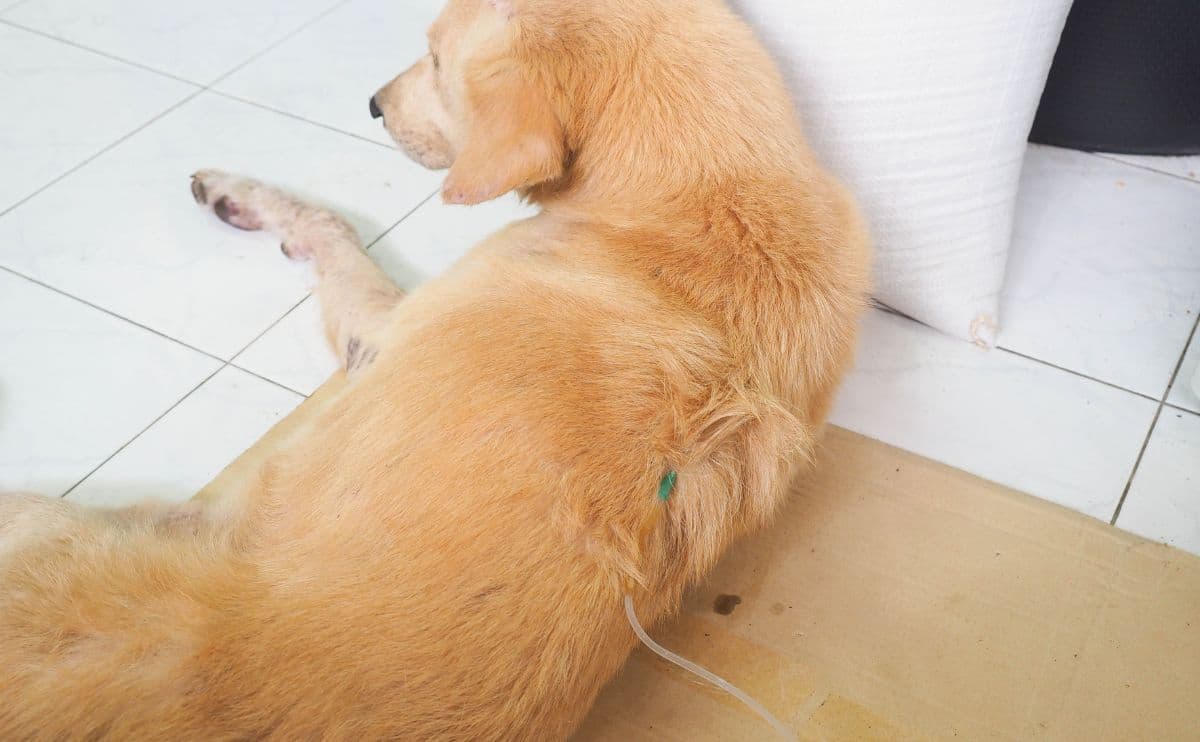This content was reviewed by veterinarian Dr. JoAnna Pendergrass, DVM.
When you purchase through links on our site, we may earn a commission. Here’s how it works.

Bees, wasps, hornets, gnats, and other bugs are some of nature’s little miracles for a curious canine. It’s hard for pups to resist these flying and buzzing wonders. Unfortunately, dogs don’t understand the pain these insects can inflict and can often pay the price. If your dog gets stung by a bee, what do you do? In most cases, you can help them at home. But sometimes, a dog bit by a bug can suffer severe reactions, so it’s important to know when it’s time for emergency care.
- My Dog Got Stung By A Bee Or Bit By A Bug
- Dog Stung By Bee Symptoms
- Insect Bites On Dogs Home Treatment
- Dog Bee Sting Or Other Bug Bite Treatment
- Dog Allergic Reaction To Bug Bite
- Dog Stung By Bee: Severe Symptoms
- What If My Dog Keeps Swelling?
- Frequently Asked Questions
- How Pet Insurance Can Help When Emergencies Arise?
My Dog Got Stung By A Bee Or Bit By A Bug
What should I do if my dog gets stung by a bee or wasp? Or you are wondering, “My dog stepped on a bee. Now what?” Keep a watchful eye on your dog. It’s crucial to closely monitor your dog for at least 30 minutes after a bee sting to make sure they’re not exhibiting any serious symptoms. Also, if your dog is stung multiple times, you should contact your veterinarian immediately.

If your dog suddenly chews at her foot, paws at her face, or tries to rub her face on the ground, she could have been stung. Look around the area to see if you can spot the bee, wasp, hornet, etc., or another offender like a spider. (Spiders are not always easy to spot and may be poisonous, so capture and secure it in a tightly sealed container if possible.)
Dog mosquito bites are also common, and we recommend looking into pet-friendly mosquito repellents, especially in the summer months when they are more rampant. Gnat bites on dogs can also be an issue.
Bee Stinger In Dog
If it’s a bee sting, try to see if the stinger is still in your dog’s skin. Embedded stingers continue to secrete venom, so it’s essential to remove them quickly to reduce the amount of toxin injected into your dog. Remove the stinger by scraping over it with your fingernail or a credit card. Don’t use tweezers because they could squeeze more venom into your dog.
Dog Stung By Bee Symptoms
What are the most common dog bee sting symptoms? Most dogs experience mild swelling and redness from a bee, wasp, or hornet sting. The discomfort may cause limping. But it’s important to monitor your dog to make sure her symptoms don’t worsen (see a list of severe symptoms below). Dog bug bites on their belly might be harder for them to scratch or itch.
Insect Bites On Dogs Home Treatment
Looking for natural remedies for bug bites on dogs? Here’s how to treat a bee sting or bug bite on a dog that’s having a mild reaction:
- Soothe a bee sting with a thick paste of baking soda and water due to the acidic nature of bee venom. But, if your dog is stung by a wasp or hornet, you should neutralize it with vinegar or lemon juice.
- If there are multiple stings, you can relieve your dog’s discomfort with an oatmeal bath.
- Apply a cold compress to reduce swelling and pain. A washcloth soaked in cold water should do the trick, but you can also use a towel-wrapped ice pack or bag of frozen peas. Whichever method you use, apply the cold material for at least 10 minutes.
Dog Bee Sting Or Other Bug Bite Treatment
Dog bug bite treatment depends on the dog, the severity of the bite, and what bit them. Some dogs can have moderate reactions to stings and become very itchy. If you notice your dog scratching a lot following a bee sting, call your veterinarian’s office.
As long as your dog doesn’t have hives or facial swelling and isn’t vomiting or showing signs of distress, your vet may advise you to give your dog an oral antihistamine containing diphenhydramine (like Benadryl) to minimize the reaction and decrease itching. You can also follow the tips above to ease your dog’s pain and swelling.
Always consult your vet before giving your dog any over-the-counter medications for humans. Many are unsafe for dogs or require vet-recommended dosing that differs from what humans can take. Learn more about which over-the-counter medications are safe for dogs.
Our Personal Hornet Sting Experience

“Our dog Lily was stung on her leg by a hornet while on a walk. We gave her Benadryl as soon as we got home and monitored her symptoms closely for any changes. We also iced the area for 10 minutes every hour during waking hours. While she was still limping, this treatment combo helped to reduce some of the swelling and discomfort. Luckily, she was feeling much better after about 30 hours.”
– Michelle Schenker, dog parent to two rescue dogs
Dog Allergic Reaction To Bug Bite
Can dogs be allergic to bees? Yes, some dogs can suffer severe reactions (anaphylactic shock) to bee stings, just as some humans do, and dogs could die if they don’t get immediate veterinary attention. Anaphylaxis in humans produces breathing problems. Not always with dogs.
The most common signs that dogs are going into anaphylactic shock is if they start vomiting or have diarrhea within a few minutes (or even up to 20 minutes) after a bee sting — they may also have hives, excessive drooling, and pale gums. If this happens, don’t wait. Take your dog to your vet or the emergency clinic immediately.
Dog Stung By Bee: Severe Symptoms

There are several severe symptoms. If you notice any of these after your dog is stung, seek immediate medical attention at a veterinary office
- Severe swelling around the head and neck — this could compromise your dog’s ability to breathe
- Vomiting or diarrhea
- Difficulty breathing or wheezing
- Excessive drooling — swelling in the throat can cause a buildup of saliva because the dog has difficulty swallowing
- Hives on any part of the body (they appear as red bumps on hairless areas and bumps under the skin that raise the hair)
- Pale gums
- Excessive agitation
- Dizziness or disorientation
- Seizures
Emergency Vet Treatment
If your dog has an anaphylactic reaction, your vet likely will give your dog epinephrine, which will open up the airways and increase blood pressure (among other effects) to treat the anaphylaxis.
Your vet may also give your dog steroids to reduce inflammation. Depending on your dog’s symptoms, your vet may also administer intravenous fluids and oxygen to help respiration.
They may also conduct blood and urine tests to ensure your dog’s organs haven’t been damaged. Your dog will require monitoring in the hospital until she’s stabilized.
What If My Dog Keeps Swelling?
This video has some excellent advice from a veterinarian about when swelling gets bad enough to seek medical attention for your dog.
Frequently Asked Questions
Here are some frequently asked questions regarding dog bee stings from our readers.
How Long Does A Bee Sting Last On A Dog?
What’s a typical dog bee sting recovery time? With a mild or moderate reaction, the bee sting site will be red and slightly swollen. The sting site should clear up within a day or two. Try to keep your dog from excessively scratching or licking the area to prevent infection. An Elizabethan collar (aka a cone) can help with preventing your dog from bothering the sting site.
My Dog Got Stung By A Bee In Mouth: What Should I Do?
If your dog was stung on her mouth, tongue, or throat or has eaten a bee, you need to keep a close eye on her. Stings inside the mouth can cause severe facial or neck swelling, which may block your dog’s airway and compromise her ability to breathe. So if your dog was stung in her mouth, contact your vet immediately.
What If My Dog Got Stung By A Bee On Her Paw And Is Now Limping?
Dogs often get stung on the pads of their paws by stepping on a bee or trying to swat at a bee. This can cause your dog to limp temporarily because of the pain from the sting. If this happens, follow our advice above to ensure your dog isn’t having any serious symptoms.
If your dog isn’t having serious symptoms, you can use a home treatment to help ease the pain. If your dog continues to limp after 24 hours or so, it’s a good idea to contact your vet.
How Pet Insurance Can Help When Emergencies Arise?
Emergencies can happen anytime with your pup. You may want to consider signing up for pet insurance as a proactive measure to lower your financial risk for potential health threats during your dog’s lifetime. Why? Pet insurance is one of the best things you can do for your dog — not only for the health of your pup but to save you from financial trouble should an accident, illness, or pet emergency arise. Check out our comparison of the top pet insurance providers to learn more.
Tagged With: Allergies, Medication, Reviewed By Dr. Pendergrass, DVM

